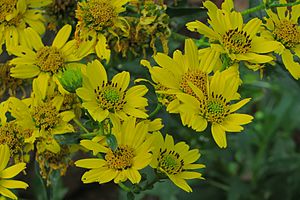Bigleaf crownbeard facts for kids
Quick facts for kids Bigleaf crownbeard |
|
|---|---|
 |
|
| Conservation status | |
| Scientific classification | |
| Genus: |
Verbesina
|
| Species: |
dissita
|
Verbesina dissita, also known as bigleaf crownbeard, is a special flowering plant. It belongs to the aster family, which includes sunflowers and daisies. This plant is quite rare, meaning there are not many of them left in the wild.
Bigleaf crownbeard grows naturally in northern Baja California, Mexico. Scientists have found about 23 groups of these plants there. However, some of these groups might have disappeared, or they are in danger of being destroyed. The plant also grows along a small part of the coast near Laguna Beach in southern California. This area is very developed, which puts the plant at risk.
This plant faces several threats. Erosion, which is when soil and rock are worn away, can harm its habitat. Also, other plants that are not native to the area can grow too much and take over, competing with the bigleaf crownbeard for space and resources. Because it is so rare and threatened, the United States government has listed it as a federally threatened species. This means it has special protection to help it survive.
What Does Bigleaf Crownbeard Look Like?
Bigleaf crownbeard is a type of small shrub. It usually grows to be about 50 centimeters (about 20 inches) to over a meter (about 3 feet) tall.
Leaves and Stems
The leaves of this plant are green and grow in pairs opposite each other on the stem. Each leaf is oval-shaped and can be up to 12 centimeters (about 5 inches) long and 6 centimeters (about 2.5 inches) wide. The leaves can be smooth or have a few hairs. Their edges are usually smooth or have very small teeth.
Flowers and Seeds
The plant produces groups of flowers that look a lot like small sunflowers. Each group can have up to 16 flower heads. These flower heads have bright yellow "petals" around the outside, which are called ray florets. Each ray floret can be up to 2.5 centimeters (about 1 inch) long.
In the center of each flower head, there are up to 100 tiny flowers called disc florets. These disc florets have long yellow tubes and dark brown parts called anthers, which hold pollen. After the flowers bloom, they produce seeds. The fruit of the plant is a brown, winged seed called an achene. It is over a centimeter long and has a feathery top called a pappus, which helps the seed float away in the wind.


